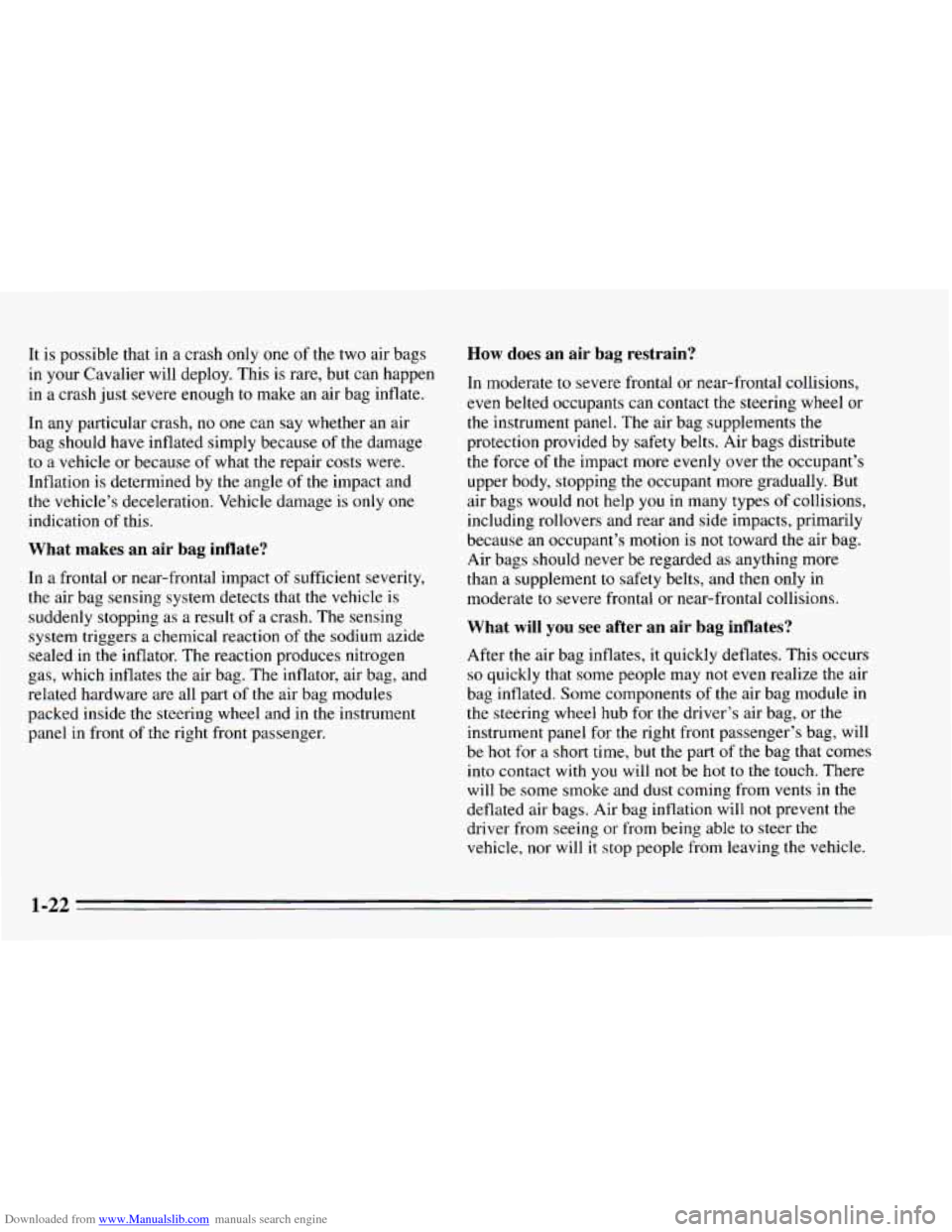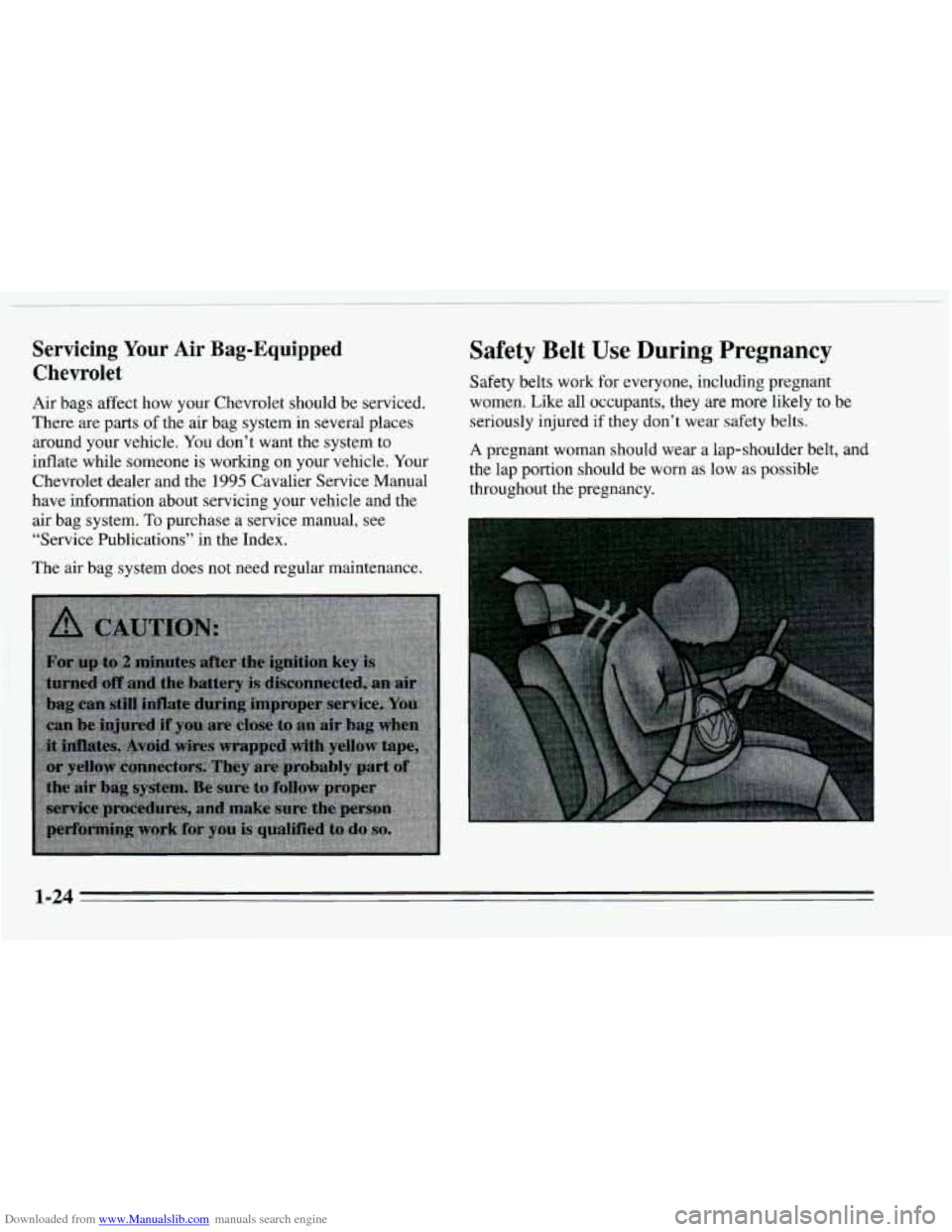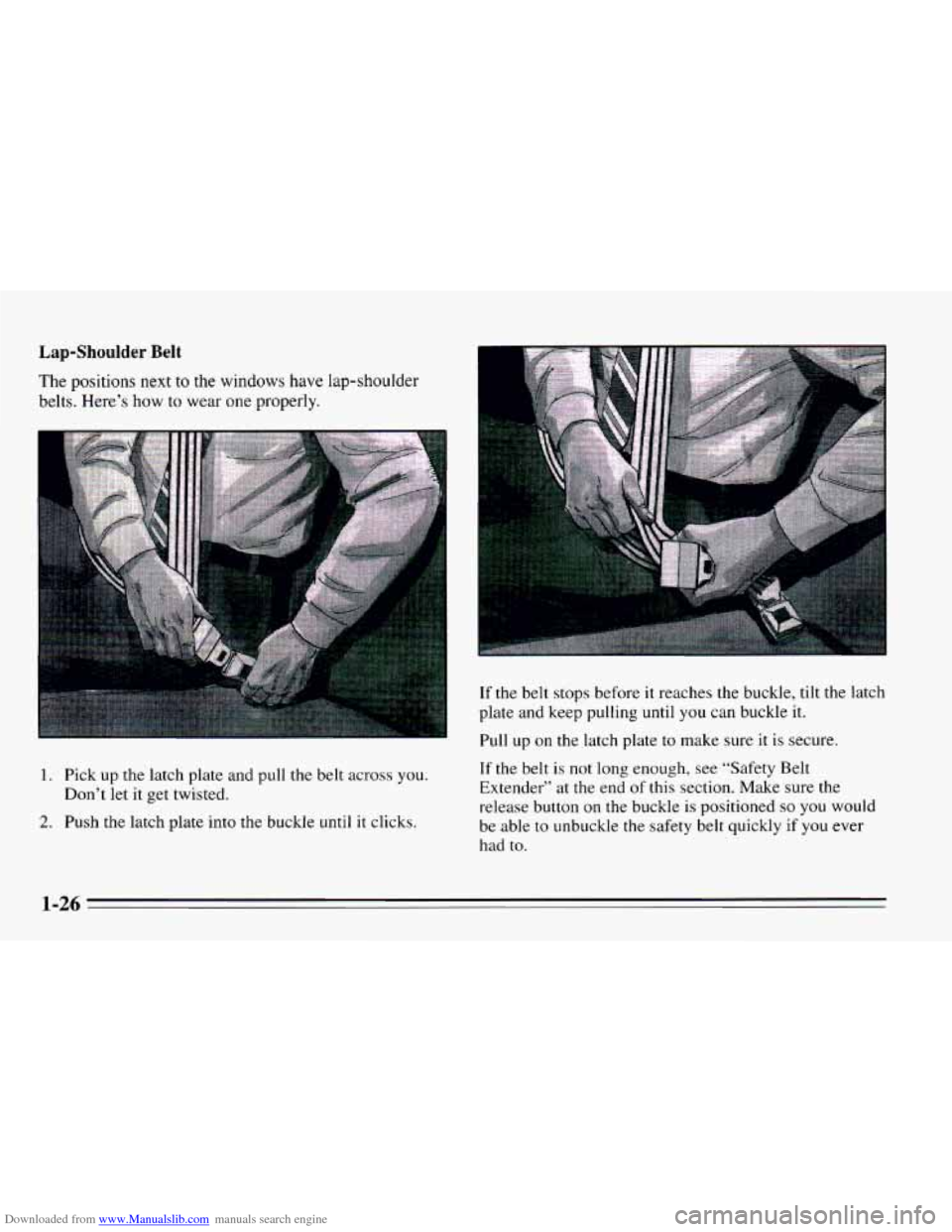CHEVROLET CAVALIER 1995 3.G Owner's Guide
Manufacturer: CHEVROLET, Model Year: 1995, Model line: CAVALIER, Model: CHEVROLET CAVALIER 1995 3.GPages: 340, PDF Size: 17.09 MB
Page 31 of 340

Downloaded from www.Manualslib.com manuals search engine The right front passenger’s air bag is in the instrument
panel on the passenger’s side.
When should an air bag inflate?
The air bag is designed to inflate in moderate to severe
frontal or near-frontal crashes. The air bag will inflate
only if the impact speed is above the system’s designed
“threshold level.” If your vehicle goes straight into a
wall that doesn’t move or deform, the threshold level
is
about 9 to 15 mph (14 to 24 kmh). The threshold level
can
vary, however, with specific vehicle design, so that
it can be somewhat above or below this range. If your
vehicle strikes something that will move or deform, such
as a parked car, the threshold level will be higher. The
air bag is not designed to inflate in rollovers, side
impacts, or rear impacts, because inflation would not
help the occupant.
1-21
Page 32 of 340

Downloaded from www.Manualslib.com manuals search engine It is possible that in a crash only one of the two air bags
in your Cavalier will deploy. This is rare, but can happen
in a crash just severe enough
to make an air bag inflate.
In any particular crash,
no one can say whether an air
bag should have inflated simply because of the damage
to a vehicle or because of what the repair costs were.
Inflation
is determined by the angle of the impact and
the vehicle’s deceleration. Vehicle damage
is only one
indication of this.
What makes an air bag inflate?
In a frontal or near-frontal impact of sufficient severity,
the air bag sensing system detects that the vehicle is
suddenly stopping as a result
of a crash. The sensing
system triggers a chemical reaction of
the sodium azide
sealed in the inflator. The reaction produces nitrogen
gas, which inflates the air bag. The inflator, air bag, and
related hardware are all part
of the air bag modules
packed inside the steering wheel and in the instrument
panel in front
of the right front passenger.
How does an air bag restrain?
In moderate to severe frontal or near-frontal collisions,
even belted occupants
can contact the steering wheel or
the instrument panel. The air bag supplements
the
protection provided by safety belts. Air bags distribute
the force
of the impact more evenly over the occupant’s
upper body, stopping the occupant more gradually. But
air bags would not help
you in many types of collisions,
including rollovers and rear and side impacts, primarily
because an occupant’s motion is
not toward the air bag.
Air bags should never be regarded as anything more
than a supplement to safety belts, and then only in
moderate to severe frontal or near-frontal collisions,
What will you see after an air bag inflates?
After the air bag inflates, it quickly deflates. This occurs
so quickly that some people may not even realize the air
bag inflated. Some components of the air bag module
in
the steering wheel hub for the driver’s air bag, or the
instrument panel for the right front passenger’s bag, will
be
hot for a short time, but the part of the bag that comes
into contact with you will
not be hot to the touch. There
will be some smoke and dust coming from vents in the
deflated air bags. Air bag inflation will
not prevent the
driver from seeing or from being able
to steer the
vehicle, nor will it stop people from leaving the vehicle.
1-22
Page 33 of 340

Downloaded from www.Manualslib.com manuals search engine In many crashes severe enough to inflate an air bag,
windshields are broken by vehicle deformation.
Additional windshield breakage may also occur from the
right front passenger air bag.
0 The air bags are designed to inflate only once. After
they inflate, you’ll need some new parts for your air
bag system. If you don’t get them, the air bag system
won’t be there
to help protect you in another crash.
A new system will include air bag modules and
possibly other parts. The service manual for your
vehicle covers the need
to replace other parts.
Your vehicle is equipped with a diagnostic module,
which records information about the air bag system.
The module records information about the readiness
of the system, when the sensors are activated and
driver’s safety belt usage at deployment.
Let only qualified technicians work on your air bag
system. Improper service can mean that your
air bag
system won’t work properly. See your dealer for
service.
NOTICE:
If you damage the cover for the driver’s or the
right front passenger’s
air bag, they may not
work properly. You may have to replace the air
bag module in the steering wheel
or both the air
bag module and the instrument panel for the
right front passenger’s air bag.
Do not open or
break the air bag covers.
1-23
Page 34 of 340

Downloaded from www.Manualslib.com manuals search engine Servicing Your Air Bag-Equipped
Chevrolet
Air bags affect how your Chevrolet should be serviced,
There are
parts of the air bag system in several places
around your vehicle. You don’t want the system to
inflate while someone is working on your vehicle. Your
Chevrolet dealer and the
1995 Cavalier Service Manual
have information about servicing your vehicle and the
air bag system.
To purchase a service manual, see
“Service Publications’’ in the Index.
The air bag system does not need regular maintenance.
Safety Belt Use During Pregnancy
Safety belts work for everyone, including pregnant
women. Like all occupants, they are
more likely to be
seriously injured if they don’t wear safety belts.
A pregnant woman should wear a lap-shoulder belt, and
the lap portion should be worn as low as possible
throughout the pregnancy.
1-24
Page 35 of 340

Downloaded from www.Manualslib.com manuals search engine The best way to protect the fetus is to protect the
mother. When
a safety belt is worn properly, it’s more
likely that the fetus won’t be hurt in a crash. For
pregnant women, as
for anyone, the key to making
safety belts effective is wearing them properly.
Right Front Passenger Position
The right front passenger’s safety belt works the same
way as the driver’s safety belt. See “Driver Position,’’
earlier in this section.
Rear Seat Passengers
It’s very important for rear seat passengers to buckle up!
Accident statistics show that unbelted people in the rear
seat are hurt more often in crashes than those who
are
wearing safety belts.
Rear passengers who aren’t safety belted can be thrown
out
of the vehicle in a crash. And they can strike others
in the vehicle who are wearing safety belts.
Rear Seat Outside Passenger Positions
1-25
Page 36 of 340

Downloaded from www.Manualslib.com manuals search engine Lap-Shoulder Belt
The positions next to the windows have lap-shoulder
belts. Here’s how to wear one properly.
1. Pick up the latch plate and pull the belt across you.
Don’t let it get twisted.
2. Push the latch plate into the buckle until it clicks.
If the belt stops before it reaches the buckle, tilt the latch
plate and keep pulling until
you can buckle it.
Pull up on the latch plate to make sure it is secure.
If the belt
is not long enough, see “Safety Belt
Extender” at the end
of this section. Make sure the
release button
on the buckle is positioned so you would
be able to unbuckle
the safety belt quickly if you ever
had
to.
1-26
Page 37 of 340

Downloaded from www.Manualslib.com manuals search engine 3. To make the lap part tight, pull down on the buckle
end
of the belt as you pull up on the shoulder part. The lap
part
of the belt should be worn low and snug on
the hips, just touching the thighs-. In a crash, this applies
force to the strong pelvic bones. And you'd
be less
likely to slide under the lap belt.
If you slid under it, the
belt would apply force
at your abdomen. This could
cause serious or even fatal injuries. The shoulder belt
should go over the shoulder and across the chest. These
parts
of the body are best able to take belt restraining
forces.
Page 38 of 340

Downloaded from www.Manualslib.com manuals search engine The safety belt locks if there’s a sudden stop or a crash.
To unlatch the belt, just push the button on the buckle.
Rear Safety Belt Comfort Guides for
Children and Small
Adults
Rear shoulder belt comfort guides will provide added
comfort for children who have outgrown child restraints
and for small adults. The comfort guides pull the
shoulder belts away from the neck and head.
1-28
Page 39 of 340

Downloaded from www.Manualslib.com manuals search engine a
. ..
There is one guide for each outside passenger position in 2. Slide the guide under and past the belt. The elastic
the rear seat.
You will find them tucked in between the cord must be under the belt. Then, place the guide
seatback
and the interior body, about half-way down the over the belt, and insert the two edges of the belt into
edge
of the seatback. Here is how you should install the the slots of the guide.
comfort guides on the shoulder belts:
1. Pull the elastic cord out from between the edge of
the seatback and the interior body
to remove the
guide from its storage clip.
1-29
Page 40 of 340

Downloaded from www.Manualslib.com manuals search engine 3. Be sure that the belt is not twisted and it lies flat. The
elastic cord must be under the belt and the guide on
top. 4. Buckle the belt around the child, and make sure that
both the lap belt and the shoulder belt are secured
properly. Make sure that the shoulder belt crosses the
shoulder. See “Safety Belts, Rear Seat Passengers”
in
the Index.
1-30